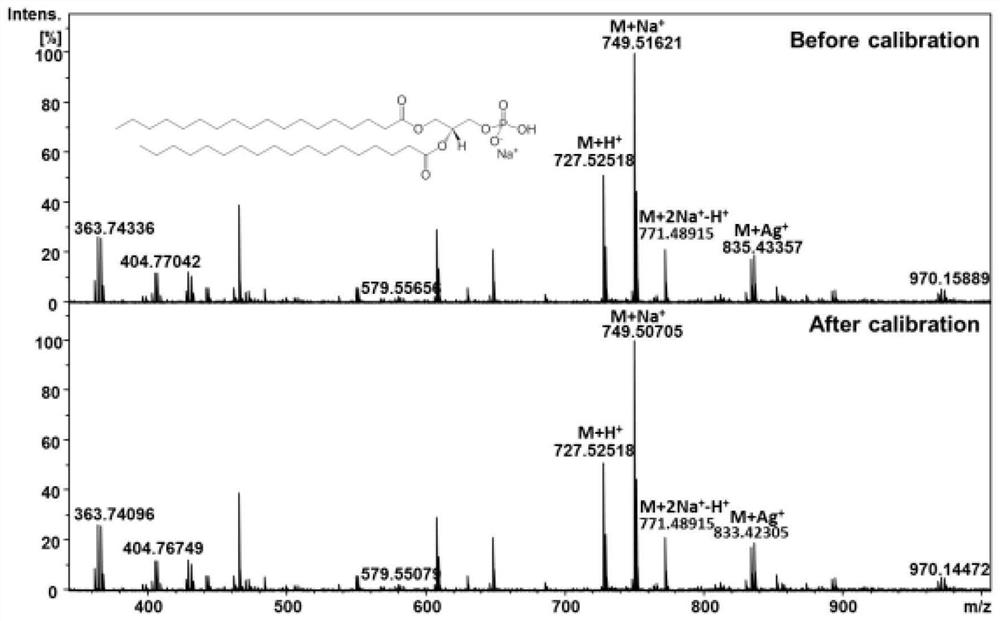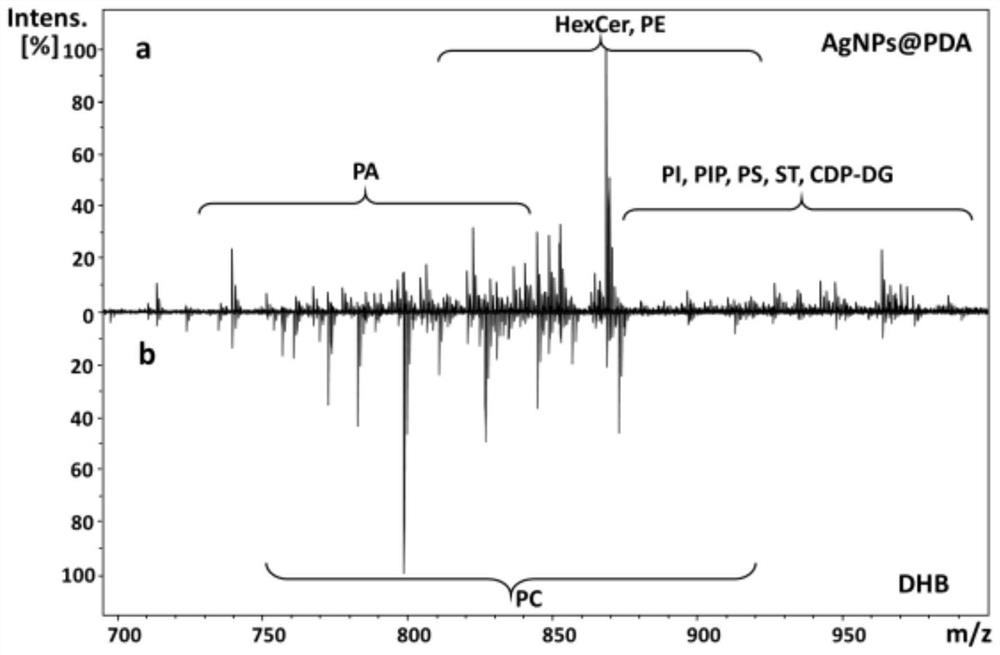Application of polydopamine-modified silver nanoparticles in mass spectrometry detection
A nanoparticle and polydopamine technology, which is applied in the field of mass spectrometry detection, achieves the effects of mild and convenient synthesis conditions, enhanced desorption and ionization ability, and simple operation
- Summary
- Abstract
- Description
- Claims
- Application Information
AI Technical Summary
Problems solved by technology
Method used
Image
Examples
Embodiment 1
[0043] Example 1, preparation of AgNPs@PDA nanoparticles
[0044] Weigh 0.4 g of dopamine and dissolve it in a round bottom flask filled with 25 mL of water, and adjust the pH value to 7.8.
[0045] Prepare 0.01g / mL silver nitrate solution (solvent is water), slowly drop 4mL into a round bottom flask, react at 60°C for 24 hours and collect samples to obtain AgNPs@PDA nanoparticles. If the dropping method is not used, the obtained AgNPs are coral-like materials, such as figure 1 as shown in a.
[0046] The transmission electron microscope images of the prepared AgNPs@PDA nanoparticles are as follows: figure 1 b, as shown in 1c, it can be seen from the figure that the AgNPs@PDA particles are spherical, with a diameter of 85-110nm, and the thickness of polydopamine is about 6.5nm. AgNPs of 3-5nm are attached to the surface of polydopamine, which can be clearly seen Silver lattice lines.
[0047] AgNPs@PDA nanoparticles have good dispersibility in water, methanol, acetonitrile...
Embodiment 2
[0048] Example 2. Using AgNPs@PDA as a MALDI matrix to detect PA (18:0 / 18:0), an example of using AgNPs@PDA's own silver cluster peak to calibrate the instrument.
[0049] Matrix dispersion liquid: Weigh 2 mg of the AgNPs@PDA particles prepared in Example 1 and dissolve in 1 mL of acetonitrile / water (80 / 20, v / v), and disperse ultrasonically for 20 min.
[0050] The preparation concentration is 10 -3 Phosphatidic acid PA (18:0 / 18:0) standard solution of M.
[0051] The matrix dispersion and the prepared standard solution were mixed according to the volume ratio of 1:1, and 2 μL was spotted on the MALDI stainless steel target surface, and dried at room temperature; then sent to a mass spectrometer for analysis.
[0052] The mass spectrometer conditions are: equipped with a 9.4T superconducting magnet Bruker solariX mass spectrometer, the laser wavelength is 355nm, the laser energy is 75%, the laser spot size is 50μm, the pulse frequency is 150Hz, and the resolution is 200000 at...
Embodiment 3
[0055] Example 3. Using AgNPs@PDA as a matrix to detect mouse brain lipid extracts in positive ion mode
[0056] Refer to Example 2 for the preparation method of matrix dispersion.
[0057] Lipid extraction: Prepare mouse brain homogenate (200mg / mL), take 50μL homogenate and add 450μL methanol, vortex for 1min, let stand for 5min, vortex for 1min, and centrifuge in a centrifuge for 10min (1000g, 4℃ ). The supernatant was collected, blown dry with nitrogen gas, and redissolved in 200 μL methanol.
[0058] The matrix solution and the re-dissolved lipid extract were mixed at a ratio of 1:1 (v / v), and then 2 μL was spotted on the MALDI stainless steel target surface with a pipette, dried at room temperature, and sent to a mass spectrometer for analysis.
[0059] The mass spectrometer conditions are: equipped with a 9.4T superconducting magnet Bruker solariX mass spectrometer, the laser wavelength is 355nm, the laser energy is 75%, the laser spot size is 50μm, the pulse frequency...
PUM
| Property | Measurement | Unit |
|---|---|---|
| molecular weight | aaaaa | aaaaa |
| diameter | aaaaa | aaaaa |
| diameter | aaaaa | aaaaa |
Abstract
Description
Claims
Application Information
 Login to View More
Login to View More - R&D
- Intellectual Property
- Life Sciences
- Materials
- Tech Scout
- Unparalleled Data Quality
- Higher Quality Content
- 60% Fewer Hallucinations
Browse by: Latest US Patents, China's latest patents, Technical Efficacy Thesaurus, Application Domain, Technology Topic, Popular Technical Reports.
© 2025 PatSnap. All rights reserved.Legal|Privacy policy|Modern Slavery Act Transparency Statement|Sitemap|About US| Contact US: help@patsnap.com



